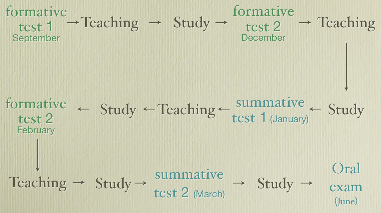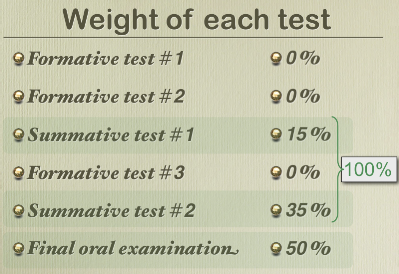One way to use degrees of certitude
Sunday 18 November 2007 at 1:48 pm 1 comment
Reading Prof. Gardner-Medwin comments (here) it obviously appears that my point of view needed some clarification. The way I use degrees of certitude will be described in this post. It is only one way, not pretending to be the best, just my way. Since degrees of certitude (or degrees of certainty) do not influence the mark it is not de facto a confidence based marking system.
Students are free to associate degrees of certitude with their answers. If they don’t use degree of certitude or if they use them being wrong or being right their score will not change. They answer MCQ choosing one out of 7 to 8 propositions, 4 being always the same: none of the proposition, all propositions together, missing data to answer the question, the question doesn’t make sense. The tariff is
- for a correct answer: +1
- for an incorrect answer: -0.5
- for not answering or omission: -0.25
Training a) to answer this kind of MCQ, b) to use degrees of certitude and c) specific training regarding the topics evaluated with these tests are organised, both on line and during simulated exams. Students are free to participate. If not using CBM they receive their scores. Students using CBM for all their answers receive detailed results. They connect to the web and using their student identity number they download their full results.
On a willing base they can answer 20 questions about their performance helping them to analyse their results and regulate their learning for the next test.
Five tests are organised during the year. None is mandatory. Student are free not to participate to any and only take the final oral exam.
- The first lesson in September is a test about prerequisite knowledge.
- The second test in December is a formative training test with MCQ and open ended questions covering all subjects seen at the point of the formation.
- The third test in January is a summative test that will influence the final score if the test is taken. It is the same kind of test than the previous.
- The fourth test in Ferburay is a formative evaluation covering all subjects of the year course.
- The fifth test in March is a summative test covering all subjects of the year course.
The first summative test, if taken, will count for 15% of the final score. The second summative test, if taken, will count for 35% of the final score. The oral exam in June will take the remaining percentage, meaning
- 100% if no test was taken during the year,
- 85% if the first summative test was taken,
- 65% if the second summative test was taken,
- 50% if both summative test were taken.
If a student pass both summative tests with a score above 60% he then can choose
- to take the oral exam for 50% of the final score.
- to report his score to the oral exam so that his grade for both summative tests will be his final grade.
Any student who has not taken both test or not passed with 60% or more is obliged to take the oral exam. Any student who has taken all 5 tests and reached a score between 45% and 60% will be evaluated on the quality of his comments. If metacognitive analysis and regulations are “good” bonus points will be added to the student actual score. The bonus points allow the student to reach the 60% needed to be able to keep his grade and not being obliged to take the oral exam.
It is a long explanation. Let’s hope it makes things easier to understand. Next post will present the tool the help student to analyse and regulated their learning using results collected with the use of CBM.
Entry filed under: confidence marking, degree of certainty, degree of certitude, education, evaluation, metacognition, reckoner, tariff.
Either you know or you don’t Definition of metacognition
1 Comment Add your own
Leave a comment Cancel reply
Trackback this post | Subscribe to the comments via RSS Feed


1. music | Tuesday 8 January 2008 at 1:54 pm
music | Tuesday 8 January 2008 at 1:54 pm
very interesting.
i’m adding in RSS Reader